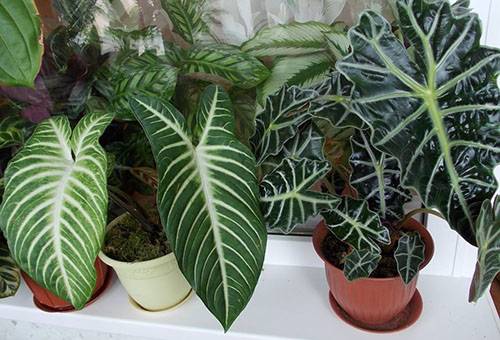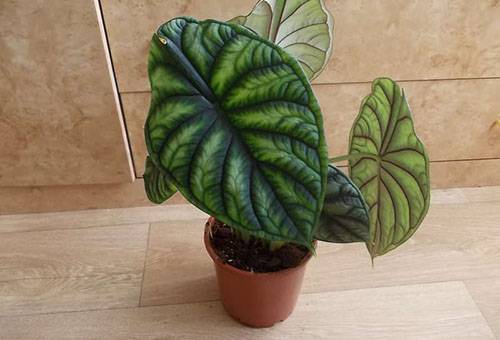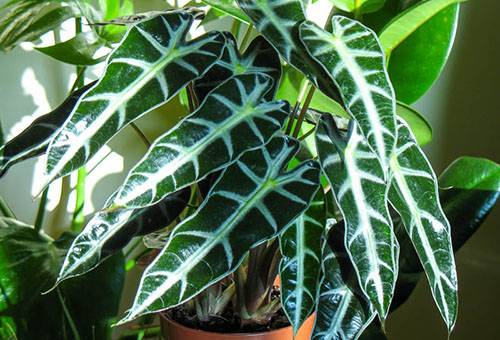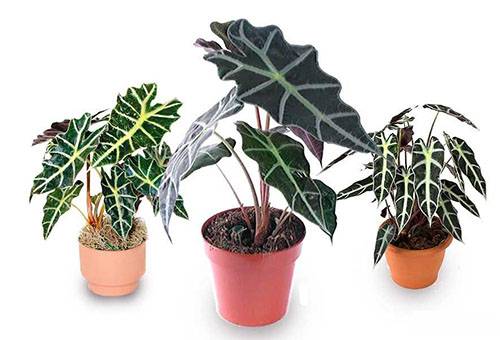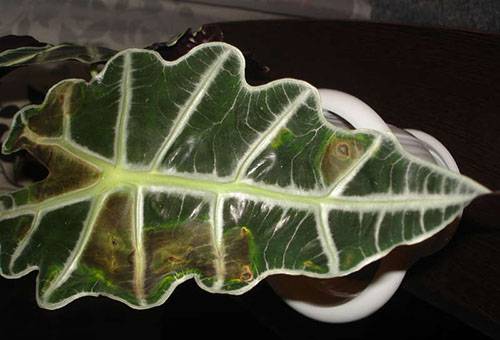How to ensure competent alocasia care at home?
Content:
Alocasia is a very whimsical plant, it is not easy to provide it with competent care at home. In order for the plant to feel good, constant monitoring of compliance with all conditions of its maintenance is necessary. Even for a couple of days you should not leave her unattended.
What is alocasia?
The plant belongs to the group of evergreens, has large oval leaves with distinct veins that are located on long, juicy petioles. About 70 species are grown at home, but the following are most popular: Polly, Sandera, Bambino, Black Velvet.
Plants of different species differ in height (from several tens of centimeters to a couple of meters), the size of the leaves, their color. Therefore, many flower growers acquire several types at once. They all require the same care, and at the same time look very picturesque. Even in ideal home conditions, alocasia rarely blooms, but sometimes it happens. The flowers are small and very fragrant.
House growing conditions
The natural habitats of alocasia are the tropics. And when caring for alocasia at home, it is necessary to create conditions as close to tropical as possible.
Temperature and humidity conditions
The plant loves high temperatures. In the warm season, it should be at least 20-25 degrees, in winter - at least 18 degrees. Tropical conditions mean high humidity (about 80%), so the plant needs regular spraying, and the hotter the room, the more often it needs to be done. It is preferable to use a spray gun that produces small, more mist-like droplets. A good solution would be to install an automatic humidifier. You can also periodically wipe the leaves with a damp cloth, but polishing is not recommended. A pot with a plant is advised to be placed on a pallet with wet pebbles or expanded clay. In winter, humidity should not fall below 40%, and in summer - 50%.
When leaving, it is very important to observe the watering regime, because both waterlogging of the soil and its excessive dryness are harmful to the plant. In spring, alocasia must be watered abundantly - immediately as the topsoil dries. After half an hour or an hour, excess water from the stand for the pot must be drained. Autumn-winter watering is somewhat less intense, it is produced the next day after the soil in the pot has dried.
A signal of insufficient soil moisture is sluggish weak leaves with drying tips. With excessively dry soil, it is very likely that mites will actively proliferate in the pot with the plant.
Illumination
Alocasia is photophilous, but does not tolerate direct sunlight, the leaves begin to turn yellow, dry and eventually fall off. Ideal lighting should be bright but diffused. If monotonous species still somehow can tolerate a lack of light, then variegated varieties, for example Polly, sometimes have to arrange additional illumination.
Soil requirements
As for the type of soil, alocasia prefers slightly acidified soil, which must be loosened regularly to provide the roots of the plant with air. Otherwise, they begin to rot.
Periodically (at least once a month) the plant must be fed with complex or specialized fertilizers, especially potash.
Transfer
It’s easy to understand that it’s time to transplant the plant - you can see with the naked eye when the old pot is small.An additional indicator will be that the roots of alocasia are entangled in a lump of earth, and sometimes even begin to stick out from the drainage hole. On average, a transplant is needed once a year.
Pots should be selected tall and narrow from ceramic or plastic, the size is selected only a few centimeters more than the previous pot.
Tip
Alocasia juice, like many aroid plants, is poisonous. Of course, he will not lead to death or severe poisoning, but a burn when it gets on the skin or mucous membranes is guaranteed. Therefore, all work on the care, transplantation and cutting of the plant must be carried out with gloves and beware of splashing the juice into the eyes.
Breeding
Alocasia propagates in many ways.
- The seeds. They should be sown immediately after collection in fertile soil to a shallow depth, regularly sprayed and maintained at a temperature of about 23-24 degrees. Shoots appear in the period from a few days to two to three weeks.
- Rhizomes. If necessary, one rhizome can be divided into several parts, dusting the cut with charcoal or letting it dry on its own.
- Tubers. Maybe in the spring. You can transplant seedlings when at least one leaf appears.
- Cuttings. For propagation, it is necessary to choose large healthy leaves, cut them with a sharp knife at an angle of 45 degrees and treat the cut with growth stimulants.
Possible diseases and problems
Most diseases are associated with improper care and are treated, respectively, by improving the conditions of the plant at home.
- Slowed growth is usually associated with a lack of nitrogen compounds in the soil, the situation can be corrected by regular top dressing.
- Sluggish and drying leaves may indicate insufficient watering. However, if there is enough liquid for the plant, and similar symptoms are observed, then this indicates water with a large amount of impurities. In such a situation, it is better to change the soil, and pour alocasia with filtered or at least stagnant water.
- Pale leaves are a sign that the plant has little light. And dark spots on them mean that alocasia is standing in the drafts or is exposed to sharp temperature drops during the day.
- Rotting of the whole plant or any part of it indicates excessively dense soil, as a result of which a disease common to many plants develops - root rot. Alocasia should be removed from the pot completely, the decayed areas should be removed, cuts should be treated with fundozol, and in the future, regularly and thoroughly loosen the soil in the pot. Even if the plant was brought to such a state that all the leaves died, then with a relatively good condition of the root system, it has a good chance to survive, provided that it is well-maintained.
- Pests most often occur in excessively dry soil. With a small lesion of the plant, it is necessary to normalize watering, and wipe the leaves with soapy water, with a large number of pests, special pesticides cannot be dispensed with.
With normal care, new leaves on alocasia grow more than the previous ones, the plant throws tubers in the spring and sometimes blooms. Small young leaves indicate an insufficient nutrition of the plant.
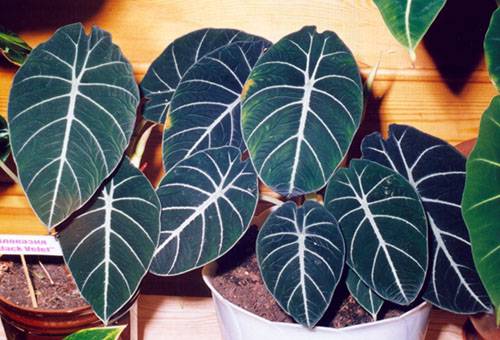
Alocasia of the Velvet variety
Due to the difficult conditions of detention, it often happens that alocasia is already sold in a weakened, painful condition, and the likelihood that it can be cured at home is small. Therefore, it is worth acquiring alocasia only if it is uniquely healthy, when the plant has a minimum of 3-4 large leaves. Immediately after the purchase, the flower must be transplanted into a pot with fresh soil, it is advisable not only to shake off the old soil from the roots, but even to wash it off and carefully follow all the care recommendations.
Check out the article: monster care
